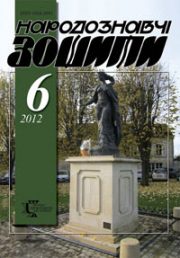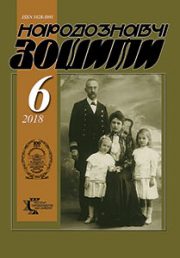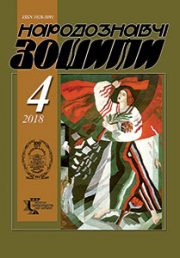The Ethnology Notebooks. 2019, № 6 (150), 1517—1524
UDK75. 071. 1. 041. 5 (477) “18”
DOI https://doi.org/10.15407/nz2019.06.1517
THE IMAGE OF MOSES IN PAINTINGS OF KORNYLO USTYIANOVYCH: VISUAL RECEPTION
KOVAL Andriy
ORCID: https://orcid.org/0000-0002-8009-1744
Lecturer of the graphic design department,
Lviv National Academy of Arts
Kubiiovych, 38, 79011, m. Lviv, Ukraine
Contacts: e-mail: koval.andr18@gmail.com
Abstract. Kornylo Ustyianovych created a famous monumental painting called Moses visualizing a strong characterful personality of a confident leader of the nation. In this article, we focus on the previously unknown art works of K. Ustyianovych. By the way of exploratory research, we managed to discover four icons with this motif: in churches of Mykolayiv of Lviv region, Butyny village and Motsoshyn village of Zhovkva district, Volosianka village of Skole district of Lviv region, Sadzhava village of Bohorodchany district. We also found around two dozen of similar art works — monumental wall paintings in the dome space, icons of various formats in the Old Testament and the Prophet’s tiers. It is a first discovery of the artist’s works in the church monumental painting. In his works, the painter tried to picture Moses as a leader of the nation, a strong characterful personality ready to devote himself to the people. He tried to form associative connections through the prism of future state-building processes.
Certain works are similar to the art piece from the Church of the Transfiguration in Lviv by its iconographic structure and compositional conception. The central part of the monumental wall painting is often modified. The artist’s work in the church in Butyny village of Zhovkva district accentuates namely the middle ground picturing an impressive scene. With his every new art work, Kornylo Ustyianovych enriched his artistic heritage with new symbols and graphic motifs. We can trace the tendency of the artist’s development within the boundaries of the iconographic tradition. The thematic content of icon paintings is closely connected with the Bible traditions and is based on the Holy Scripture. This is evidenced by two paintings found in churches of Volosianka village near Slavske and Vistova village. The works have different formats, but similar compositional structures. While the icon from Vistova village is small-sized, the art piece in Volosianka church is a monumental object. In the works described above, we can trace a specific personal style of the artist, particularly the style of image presentation. They have an underlying reception of the grandeur of the image of Moses with a philosophic mood that promotes deep artistic expression.
Keywords: iconography, biblical themes, church monumental painting, plots, color palette.
Received 24.11.2019
REFERENCES
Stankevich, M. (Ed). (2006). Dictionary of Ukrainian Sacred Art. Lviv [in Ukrainian].
Franco, I. (1980). The word of criticism. In Ivan Franko. Works (Vol. 26, pp. 17—19) [in Ukrainian].
Lepky, B. (1991). Franko in Zhukov. In B. Lepky. The story, the memories, the speeches (Vol. 2). Kyiv: Dnipro [in Ukrainian].
Nanovsky, Ya. (1963). Kornylo Ustyanovich. Kyiv [in Ukrainian].
Zheplinskaya, O. (2013). Kornylo Ustyanovich (1839—1903): painting, graphics, manuscripts. Album catalog. Kyiv: «R.K. Master Print» [in Ukrainian].
«Moses» by Kornil Ustianovich (1887). Dilo (Part 140) [in Ukrainian].
Nauka, piece and literature. (1887). Dilo (Part 62—63) [in Ukrainian].
(1889, june). Dilo, 1 (13) (Part 121) [in Ukrainian].
(1888, april). Dilo, 6 (18) (Part 77) [in Ukrainian].
Lutsik, Ya. (2011). Lives of the Saints. Lviv: Svichado [in Ukrainian].
Voytovich, V. (Ed). (2005). Ukrainian mythology. Kyiv [in Ukrainian].
Marchak, V. (2018). About painting. Tutorial. Lviv: Steblyak O.M [in Ukrainian].
Kotsovsky, V. (1888). Moses (The image of Kornil Ustianovich). Zorya (Part 1, p. 18) [in Ukrainian].
The Holy Scriptures of the Old and New Testaments. (1991). United Bible Societies [in Ukrainian].
Kupchinska, L. (2009). Creativity of Theophilus Kopistynsky in the context of the development of fine arts of Western Ukrainian lands of the second half of the nineteenth and early twentieth centuries. Lviv; Philadelphia [in Ukrainian].






